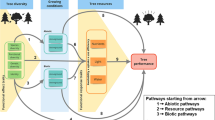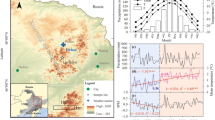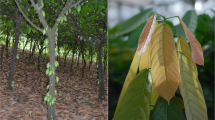Abstract
We examined crown architecture and within crown leaf area distribution effects on Pinus taeda L. growth in North Carolina (NC), Virginia (VA), and Brazil (BR) to better understand why P. taeda can grow much better in Brazil than in the southeastern United States. The NC, VA, and BR sites were planted in 2009, 2009, and 2011, respectively. At all sites, we planted the same two genetic entries at 618, 1236, and 1854 trees ha−1. In 2013, when trees were still open grown, the VA and NC sites had greater branch diameter (24%), branch number (14%), live crown length (44%), foliage mass (82%), and branch mass (91%), than the BR site. However, in 2017, after crown closure and when there was no significant difference in tree size, site did not significantly affect these crown variables. In 2013, site significantly affected absolute leaf area distribution, likely due to differences in live crown length and leaf area, such that there was more foliage at a given level in the crown at the VA and NC sites than at the BR site. In 2017, site was still a significant factor explaining leaf area distribution, although at this point, with crown closure and similar sized trees, there was more foliage at the BR site at a given level in the crown compared to the VA and NC sites. In 2013 and 2017, when including site, genetic entry, stand density, and leaf area distribution parameters as independent variables, site significantly affected individual tree growth efficiency, indicating that something other than leaf area distribution was influencing the site effect. Better BR P. taeda growth is likely due to a combination of factors, including leaf area distribution, crown architecture, and other factors that have been identified as influencing the site effect (heat sum), indicating that future work should include a modeling analysis to examine all known contributing factors.







Similar content being viewed by others
References
Albaugh TJ, Fox TR, Yanez MA, Rubilar RA, Goldfarb B (2016) Will crown ideotype help determine optimum varietal silviculture? Proceedings of the 18th biennial southern silvicultural research conference Gen. Tech. Rep. SRS-212, pp 302–307
Albaugh TJ, Allen HL, Dougherty PM, Kress LW, King JS (1998) Leaf area and above- and belowground growth responses of loblolly pine to nutrient and water additions. For Sci 44(2):317–328
Albaugh TJ, Allen HL, Fox TR (2006) Individual tree crown and stand development in Pinus taeda under different fertilization and irrigation regimes. For Ecol Manage 234(1):10–23
Albaugh TJ, Allen HL, Stape JL, Fox TR, Rubilar RA, Carlson CA, Pezzutti R (2010) Leaf area duration in natural range and exotic Pinus taeda. Can J For Res 40:224–234
Albaugh TJ, Fox TR, Maier CA, Campoe OC, Rubilar RA, Cook RL, Raymond JE, Alvares CA, Stape JL (2018) A common garden experiment examining light use efficiency and heat sum to explain growth differences in native and exotic Pinus taeda. For Ecol Manage 425:35–44
Archontoulis SV, Miguez FE (2015) Nonlinear regression models and applications in agricultural research. Agron J 107(2):786–798
Arsenault JL, Pouleur S, Messier C, Guay R (1995) WinRHIZO, a root measuring system with a unique overlap correction method. HortScience 30:906
Cannell MGR (1989) Physiological basis of wood production: a review. Scand J For Res 4:459–490
Carbaugh ED (2015) A comparison of crown attributes for six genotypes of Pinus taeda as affected by site and management intensity. Master in Forestry, Virginia Tech
Chmura DJ, Tjoelker MG, Martin TA (2009) Environmental and genetic effects on crown shape in young loblolly pine plantations. Can J For Res 39:691–698
Clark A, Saucier JR (1991) Influence of planting density, intensive culture, geographic location, and species on juvenile wood formation in southern pine. Georgia Forest Research Paper 85, pp 1–14
Fox TR, Jokela EJ, Allen HL (2007) The development of pine plantation silviculture in the southern United States. J For 105(5):337–347
Gillespie AR, Allen HL, Vose JM (1994) Amount and vertical distribution of foliage of young loblolly pine trees as affected by canopy position and silvicultural treatment. Can J For Res 24(7):1337–1344
Goncalves JL, Alvares CA, Higa AR, Silva LD, Alfenas AC, Stahl J, Ferraz SF, Lima WP, Brancalion PH, Hubner A, Bouillet JP, Laclau JP, Nouvellon Y, Epron D (2013) Integrating genetic and silvicultural strategies to minimize abiotic and biotic constraints in Brazilian eucalypt plantations. For Ecol Manage 301:6–27
Gundale MJ, Kardol P, Nilsson MC, Nilsson U, Lucas RW, Wardle DA (2013) Interactions with soil biota shift from negative to positive when a tree species is moved outside its native range. New Phytol 202:415–421
Harms WR, De Bell DS, Whitesell CD (1994) Stand and tree characteristics and stockability in Pinus taeda plantations in Hawaii and South Carolina. Can J For Res 24:511–521
Harms WR, Whitesell CD, DeBell DS (2000) Growth and development of loblolly pine in a spacing trial planted in Hawaii. For Ecol Manage 126:13–24
Littell RC, Milliken GA, Stroup WW, Wolfinger RD, Schabenberger O (2006) SAS for mixed models. SAS Publishing, Cary
Maguire DA, Bennett WS (1996) Patterns in vertical distribution of foliage in young coastal Douglas-fir. Can J For Res 26:1991–2005
Maier CA, Johnsen KH, Butnor J, Kress LW, Anderson PH (2002) Branch growth and gas exchange in 13-year-old loblolly pine (Pinus taeda) trees in response to elevated carbon dioxide concentration and fertilization. Tree Physiol 22:1093–1106
Martin TA, Johnsen KH, White TL (2001) Ideotype development in southern pines: rationale and strategies for overcoming scale-related obstacles. For Sci 47(1):21–28
Peterson JA, Seiler JR, Nowak J, Ginn SE, Kreh RE (1997) Growth and physiological responses of young loblolly pine stands to thinning. For Sci 43:529–534
Piepho HP, Buchse A, Emrich K (2003) A hitchhiker’s guide to mixed models for randomized experiments. J Agronomy Crop Sci 189(5):310–322
Pierret A, Gonkhamdee S, Jourdan C, Maeght JL (2013) IJ_Rhizo: an open source software to measure scanned images of root samples. Plant Soil 373:531–539
Samuelson LJ, Eberhardt TL, Butnor J, Stokes TA, Johnsen KH (2010) Maximum growth potential in loblolly pine: results from a 47-year-old spacing study in Hawaii. Can J For Res 10:1914–1929
SAS-Institute (2002) SAS Version 9.1 TS. SAS Institute, Inc: Cary, NC
Schabenberger O (2013) SAS Code for some advanced experimental designs. UC Regents. http://people.math.carleton.ca/~smills/2016-17/STAT5505/SAS%20Code%20for%20Some%20Advanced%20Experimental%20Designs.htm. Accessed 13 Dec 2017
Sharma M, Burkhart HE, Amateis RL (2002) Spacing rectangularity effect on the growth of loblolly pine plantations. Can J For Res 32:1451–1459
Sprugel DG (2002) When branch autonomy fails: Milton’s Law of resource availability and allocation. Tree Physiol 22:1119–1124
Sprugel DG, Hinckley TM, Schaap W (1991) The theory and practice of branch autonomy. Ann Rev Ecol Syst 22:309–334
Vickers LA, Fox TR, Stape JL, Albaugh TJ (2011) Silviculture of varietal loblolly pine plantations: second year impacts of spacing and silvicultural treatments on varieties with differing crown ideotypes. In: Butnor J (ed) USDA Forest Service. Southern Research Station, Asheville, pp 361–365
Vose JM (1988) Patterns of leaf-area distribution within crowns of nitrogen-fertilized and phosphorus-fertilized loblolly-pine trees. For Sci 34(3):564–573
Vose JM, Allen HL (1988) Leaf-area, stemwood growth, and nutrition relationships in loblolly-pine. For Sci 34(3):547–563
Wallinger RS (2002) Intensive forest management: Growing wood and preserving biodiversity in the U.S. South and Brazil. For Oper Rev 4(3):5–11
Wang B, Seiler JR, Fox TR, Maier CA, Peterson JA, Albaugh TJ, Carter DR. Increased shade tolerance and enhanced light harvesting of lower crown foliage contributed to high productivity of loblolly pine (Pinus taeda L.) in Brazil. Tree Physiol (in preparation)
Wang N, Palmroth S, Maier CA, Domec JC, Oren R (2019) Anatomical changes with needle length are correlated with leaf structural and physiological traits across five Pinus species. Plant, Cell Environ 2019:1–15
Waring RH, Nordmeyer A, Whitehead D, Hunt J, Newton M, Thomas C, Irvine J (2008) Why is the productivity of Douglas-fir higher in New Zealand than in its native range in the Pacific Northwest, USA? For Ecol Manage 255(2008):4040–4046
Weiskittel AR, Temesgen H, Wilson DS, Maguire DA (2008) Sources of within-and between-stand variability in specific leaf area of three ecologically distinct conifer species. Ann For Sci 65
Weiskittel AR, Kershaw JA Jr, Hofmeyer PV, Seymour RS (2009) Species differences in total and vertical distribution of branch- and tree-level leaf area for the five primary conifer species in Maine, USA. For Ecol Manage 258:1695–1703
Xiao Y, Jokela EJ, White TL (2003) Species differences in crown structure and growth performance of juvenile loblolly and slash pine. For Ecol Manage 174(1–3):295–313
Xu MG, Harrington TB (1998) Foliage biomass distribution of loblolly pine as affected by tree dominance, crown size, and stand characteristics. Can J For Res 28(6):887–892
Yáñez MA, Fox TR, Seiler JR, Guerra F, Baettig R, Zamundio F, Gyenge JE (2017) Within-crown acclimation of leaf-level physiological and morphological parameters in young loblolly pine stands. Trees Struct Funct 31:1849–1857
Yáñez MA, Fox TR, Seiler JR (2015) Early responses of loblolly pine varieties and families to silvicultural intensity. For Ecol Manage 356:204–215
Yin X, Goudriaan J, Lantinga EA, Vos J, Spiertz JHJ (2003) A flexible sigmoid function of determinate growth. Ann Bot 91:361–371
Yu SF, Chambers JL, Tang ZM, Barnett JP (2003) Crown characteristics of juvenile loblolly pine 6 years after application of thinning and fertilization. For Ecol Manage 180(2003):345–352
Acknowledgements
We appreciate support from the Forest Productivity Cooperative and members for their role in the establishment and management of the trials central to this publication. We gratefully acknowledge the support provided by the National Science Foundation Center for Advanced Forest Systems, the Department of Forest Resources and Environmental Conservation at Virginia Polytechnic Institute and State University, the Departamento de Silvicultura, Facultad de Ciencias Forestales, Universidad de Concepción, the Department of Forestry and Environmental Resources at North Carolina State University and the Departamento de Ciências Florestais Universidade Federal de Lavras. Funding for this work was provided in part by the Virginia Agricultural Experiment Station and the McIntire-Stennis Program of the National Institute of Food and Agriculture, U.S. Department of Agriculture. The use of trade names in this paper does not imply endorsement by the associated agencies of the products named or criticism of similar ones not mentioned. We are grateful for ArborGen for supplying the genetic material, for the assistance of K. Peer and C. Sawyer at The Reynolds Homestead, H.C. Rohr at the North Carolina Forest Service’s Bladen Lakes State Forest, and the personnel at Valor Florestal for the installation and ongoing maintenance of the study sites.
Author information
Authors and Affiliations
Contributions
Albaugh: collected data, completed analysis, wrote and edited manuscript. Maier: collected data, provided support for work, provided comment on manuscript and analysis. Campoe: provided support for work, provided comment on manuscript and analysis. Yáñez: collected data, provided comment on manuscript and analysis. Carbaugh: collected data, provided comment on manuscript and analysis. Carter: provided support for work, provided comment on manuscript and analysis. Cook: collected data, provided support for work, provided comment on manuscript and analysis. Rubilar: provided support for work, provided comment on manuscript and analysis. Fox: original idea, provided support for work, provided comment on manuscript and analysis.
Corresponding author
Ethics declarations
Conflict of interest
The authors declare that they have no conflict of interest.
Additional information
Communicated by van der Maaten.
Publisher's Note
Springer Nature remains neutral with regard to jurisdictional claims in published maps and institutional affiliations.
Rights and permissions
About this article
Cite this article
Albaugh, T.J., Maier, C.A., Campoe, O.C. et al. Crown architecture, crown leaf area distribution, and individual tree growth efficiency vary across site, genetic entry, and planting density. Trees 34, 73–88 (2020). https://doi.org/10.1007/s00468-019-01898-3
Received:
Accepted:
Published:
Issue Date:
DOI: https://doi.org/10.1007/s00468-019-01898-3




